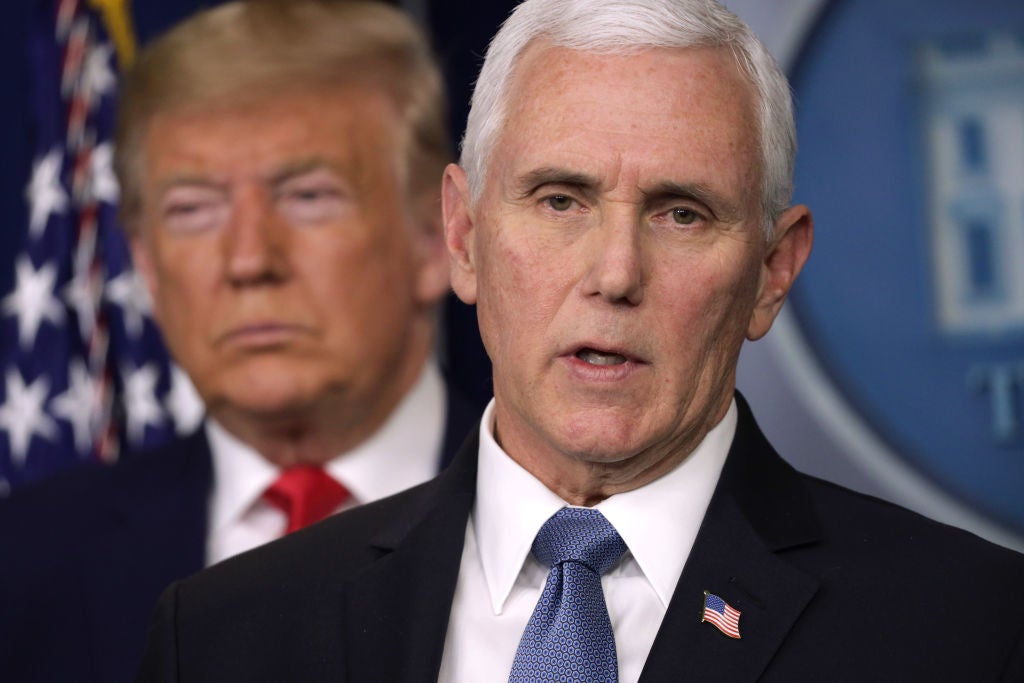What happens if the US election ends in a draw?
President Pence? A Trump-Harris administration? Sean O’Grady takes a look at what happens next in the event of a tie


There are probably as many ways the US presidential election can go wrong as there are attorneys in Donald Trump’s Rolodex.
There will certainly be claims of electoral fraud, of foreign interference, and litigation at local and federal levels. If things in the electoral college get especially confused, state governors might intervene to nominate their own alternative delegates to the college. If the courts and college cannot select a new president based on the election by the constitutional deadline of 14 December, the line of succession will kick in and the country might wind up with president Nancy Pelosi or possibly president Mike Pompeo...
All carry their own fascination, but one of the most intriguing possibilities is a draw in the electoral college. With an even number of electors this is perfectly possible – 269 each – as an absolute majority is required; a first-past-the-post plurality is insufficient. So if Joe Biden and Trump get 269 each, that’s a draw, and it becomes a “contingent election”. The Betfair website puts the odds of it happening at 33 to 1, and the excellent 270towin.com website offers 64 more or less plausible combination of swing-state votes that would deliver such a deadlock. It’s happened three times in the republic’s history, the last time in 1877 (though that one wasn’t a tie, but complicated by accusations of fraud...plus ca change).
A contingent election goes to Congress to decide, which is to say the president will be picked by the House of Representatives, and the vice president by the Senate. Each should be the “new” Senate and House. You might think that could result in a bizarre Biden-Pence administration, given that the Senate might stay in Republican hands and the House with the Democrats. However, the voting in the House would be reorganised into 50 state delegations, rather than the actual 435 voting representatives. That, in turn, would tend to favour the Republicans. At the moment (“old” House), the Republicans would control 26 such delegations, the Democrats 23 while one, Pennsylvania, is tied. That could conceivably tilt the Democrats way. So Biden gets to be president. But if the Senate picked Mr Pence as Vice President there’d be a Biden-Pence partnership. A political cohabitation between Biden and Pence would make quite the dullest spectacle, as well as an uncomfortable one. If Mr Pence couldn’t face it and quit, then Mr Biden (assuming he was president) could nominate anyone he liked, provided they would be approved by both houses of Congress in the normal way. So probably Ms Harris have her turn as Veep.
Now, in the event that the House ties in its proceedings on the presidency and cannot decide, then the “vice president” who’s been chosen by the Senate, then becomes president, until the deadlock is broken. That would likely be Mike Pence, but possibly Kamala Harris. In due course could President Pence or President Harris choose to appoint Mr Trump or Mr Biden as their Vice Presidents? The constitution is not clear on the shape of that particular rabbit hole.
There are of course other wrinkles. One or other of the older candidates might pass on during these protracted proceedings. Then there’s the attitude and rulings of the newly constituted Supreme Court, further legal challenges on state or federal grounds based on interpretation of statutes or the Constitution, and the oddity of a “special election” in Arizona (a by-election in British terms), with potentially a different swearing-in date from the other senators. Whether any of the players in these deliberations would take into account the overall popular vote can’t be easily predicted; the discrepancy between popular vote and electoral college could amount to 5 million votes.
In any case, in a sharply divided polity, the recriminations would further poison politics for years, and make the Gore-Bush imbroglio in 2000 look like a mild dispute at a polite suburban coffee morning.
The rule of thumb though, legally and politically, is clear. The larger the majority either for Trump-Pence or for Biden-Harris in the electoral college, the less chance the election ends up in an even bigger mess than any other presidential election in American history.


Join our commenting forum
Join thought-provoking conversations, follow other Independent readers and see their replies
Comments